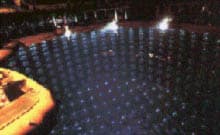The original Kamioka Nucleon Decay Experiment, or Kamiokande, was constructed between the years of 1982 and 1983 in Kamiokacho, Gifu, Japan. Located 1000 meters underground and housed in the Mozumi Mine of the Kamioka Mining and Smelting Co., Kamiokande consisted of approximately 1000 photomultiplier tubes or PMTs attached to the inner surface of a tank 16.0 m in height and 15.6 m in diameter, and submerged in 3000 tons of pure water. These PMTs detect the pale blue light emitted when neutrinos interact with charged particles and are forced to slow down to the speed of light in the liquid. The energy lost to slow down the particle creates a cone of cerenkov radiation that the PMTs detect, allowing the Kamiokande to observe rarities such as nucleon decay and neutrino events.

On February 23,1987, a supernova explosion occured in the Large Megallanic Cloud which produced the first neutrino detection ever in the world, made by Kamiokande with 11 neutrino events detected. This initiated the dawn of a new era in neutrino astronomy.
This supernova explosion was the result of the collapse of a progenitor star 20 times more massive than our Sun,occurring at the very end of the star’s evolution. An enormous amount of energy was released in the form of neutrinos in just 20 seconds, 1000 times the energy emitted by our own Sun in 4.5 billion years! From the duration of the burst of neutrinos we inferred that the mass huge energy release is in agreement with/verifies astrophysical predictions of long standing. The duration of the burst of neutrinos is also important, because from it we inferred the neutrino mass is 20 eV.